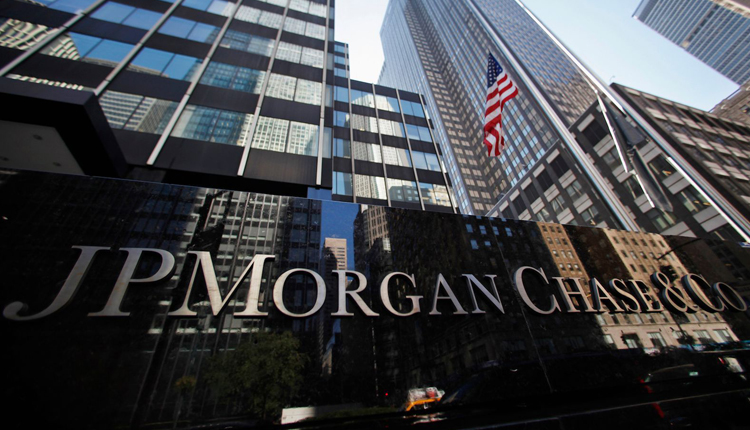J.P. Morgan Chase, the biggest U.S. lender by assets, has posted record second-quarter profit of $8.32 billion, exceeding estimates as it reported stronger-than-expected trading results.
Profit jumped 18 percent, clobbering analyst estimates for a 9.4 percent increase. Earnings per share were $2.29 in the quarter, beating the $2.22 estimate. It was the 14th straight quarter that J.P. Morgan topped analysts’ estimates, according to Barclays analysts. The company’s revenue increase was less stark, rising 6 percent to $28.4 billion.
In the company’s trading division, led by Co-President Daniel Pinto, markets revenue rose 13 percent to $5.4 billion, exceeding analysts’ estimates by a half-billion dollars. J.P. Morgan said at the end of May that it expected revenue from its trading division to be about flat from the year earlier because of several one-time charges, including a $100 million hit related to a tax-oriented fixed income unit. Analysts had expected bond and stock trading of $4.88 billion, according to a consensus from FactSet.
“There were more catalysts in the market” that helped spur volatility and therefore trading, especially in the second half of the quarter, said Chief Financial Officer Marianne Lake. Ironically, it was signs of instability in global order that helped spark trading, including the escalating U.S.-China trade dispute, unrest in emerging markets and the European Union, she said.
The bank’s traders exceeded expectations in both bond and equities departments. Fixed-income trading generated $3.5 billion in revenue, compared with the $3.18 billion estimate, on strength across asset classes and improved commodities revenue, J.P. Morgan said. Stock trading yielded $2 billion in revenue, compared with the $1.7 billion estimate, fueled by derivatives and prime brokerage results. Helped by the closing of several mega-deals, investment banking revenue of $1.9 billion beat expectations of $1.7 billion.
The firm’s shares rose 0.69 percent as of 10:52 am New York time. J.P. Morgan fared better than rivals Wells Fargo and Citigroup, which were down 1.6 percent and 2.4 percent respectively. Wells Fargo missed profit expectations amid continuing fallout from its sales practice scandals, while Citigroup disappointed some expectations for revenue and bond trading.
J.P. Morgan is the first major lender to report earnings, giving investors a glimpse into how the finance industry’s Wall Street and Main Street businesses fared in the quarter.
Chief Executive Officer Jamie Dimon indicated that J.P. Morgan took advantage of strong economic growth in the bank’s home market, citing strength across the company’s major businesses, including growth in clients investment assets, credit card results and record investment banking fees amid a boom in mergers.
“We see good global economic growth, particularly in the U.S., where consumer and business sentiment is high,” Dimon said. “Because of this broad growth and the strong underlying performance across each of our businesses, the company delivered record results this quarter. We also want to acknowledge that global competition is getting stronger.”
Still, the company’s total loans rose 4 percent to $948.4 billion, barely edging out analysts expectations for $944.5 billion. Analysts have cited concerns about slowing loan growth as a potential warning sign for the industry, which has underperformed the broader stock indexes this year.
The company’s yield on interest-earning assets, a highly watched figure of profitability in the banking world, was 2.46 percentage points, merely matching the expectations of analysts surveyed by FactSet. That was a 2 basis point decline from the first quarter, which is a potentially worrying trend for the industry.
“The trading and investment banking part of the story looks better than the traditional banking aspect right now,” said Devin Ryan, an analyst at JMP Securities. “That’s a more important read-through for companies like Goldman Sachs and Morgan Stanley where that’s a bigger part of the business.”
The performance of bank stocks has been puzzling this year. Despite lower taxes, Federal Reserve rate hikes, moves to ease regulation and accelerating economic growth, the shares of banks have underperformed the broader markets. The KBW Bank Index has declined 1.1 percent this year before Friday, lagging the S&P 500 by more than 5 percent points.
One possibility, according to Charlie Peabody, analyst at Portales Partners, is that as the U.S. enters the late stages of its economic cycle, bank profitability has peaked. For the industry, banks have had to pay depositors more interest at a faster rate than they can increase loan rates for borrowers, he said. That’s one reason banks tend to underperform at this stage of the cycle, he said.
Within J.P. Morgan’s credit card division, the company posted a quarterly charge of $330 million as customers took advantage of card rewards at a faster rate than the bank expected. It was across all of the company’s credit cards, not just the Sapphire card, according to Chief Financial Officer Marianne Lake. Executives in the card sector have talked about the heightened incentives being offered to lure customers as a “rewards war,” and J.P. Morgan helped heighten that competition with its Sapphire card.
After reshuffling his key deputies and announcing the creation of a health-care start-up in January and disclosing plans for a soaring new headquarters in February, Dimon was relatively quiet in the second quarter. In May, the bank said it had submitted an application to China’s securities regulator for a new majority-owned securities business there. Last month, J.P. Morgan, Berkshire Hathaway and Amazon announced that Dr. Atul Gawande, a Harvard professor, would lead the health-care start-up.
The bank also got approval from the Federal Reserve to boost its quarterly dividend to 80 cents per share from the current 56 cents in the third quarter and repurchase up to $20.7 billion in shares.
Source: CNBC



